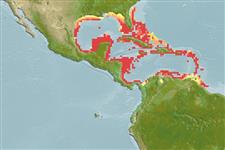Environment: milieu / climate zone / depth range / distribution range
Écologie
marin récifal; non migrateur; profondeur 1 - 70 m (Ref. 9710). Subtropical; 33°N - 35°S, 99°W - 28°W (Ref. 55265)
Western Atlantic: Florida, USA and Gulf of Mexico to Brazil. Eastern Central Atlantic: St. Paul's Rocks (Ref. 13121).
Length at first maturity / Taille / Poids / Âge
Maturity: Lm 22.0 range ? - ? cm
Max length : 45.0 cm TL mâle / non sexé; (Ref. 4858); common length : 30.0 cm TL mâle / non sexé; (Ref. 3797); poids max. publié: 1.6 kg (Ref. 26340)
Épines dorsales (Total) : 14; Rayons mous dorsaux (Total) : 19 - 21; Épines anales: 3; Rayons mous anaux: 20 - 21. Tail and pectoral fins entirely yellow. Black spot on forehead has electric blue spots and is surrounded by narrow, electric blue ring. Large blue spot at base of pectoral fin (Ref. 26938). Adults develop short spines on the margin. The color of large adults is purplish blue with yellow-orange rims to the scales; head above eye dark blue, below greenish yellow; mouth, chin, throat, chest and abdomen purplish blue (Ref. 13442)
Found on coral reefs. Generally occurs solitarily or in pairs. Moves gracefully between seafans, seawhips, and corals (Ref. 9710). Stomach contents of 26 specimens indicate that the species feeds almost exclusively on sponges supplemented by small amounts of algae, tunicates, hydroids and bryozoans. Young pick ectoparasites from other fishes (Ref. 9710). Marketed fresh (Ref. 3797).
Life cycle and mating behavior
Maturities | Reproduction | Spawnings | Egg(s) | Fecundities | Larves
Allen, G.R., 1985. Butterfly and angelfishes of the world. Vol. 2. 3rd edit. in English. Mergus Publishers, Melle, Germany. (Ref. 4858)
Statut dans la liste rouge de l'IUCN (Ref. 130435)
Menace pour l'homme
Reports of ciguatera poisoning (Ref. 30303)
Utilisations par l'homme
Pêcheries: intérêt commercial mineur; Aquarium: Commercial
Outils
Articles particuliers
Télécharger en XML
Sources Internet
Estimates based on models
Preferred temperature (Ref.
123201): 24.2 - 28, mean 26.7 °C (based on 220 cells).
Phylogenetic diversity index (Ref.
82804): PD
50 = 0.5078 [Uniqueness, from 0.5 = low to 2.0 = high].
Bayesian length-weight: a=0.03162 (0.01629 - 0.06139), b=2.89 (2.72 - 3.06), in cm total length, based on LWR estimates for this species & (Sub)family-body (Ref.
93245).
Niveau trophique (Ref.
69278): 3.0 ±0.0 se; based on diet studies.
Résilience (Ref.
120179): Faible, temps minimum de doublement de population : 4,5 à 14 années (Preliminary K or Fecundity.).
Fishing Vulnerability (Ref.
59153): Low to moderate vulnerability (35 of 100).
Nutrients (Ref.
124155): Calcium = 23.7 [10.8, 43.4] mg/100g; Iron = 0.489 [0.281, 0.849] mg/100g; Protein = 19 [18, 20] %; Omega3 = 0.146 [0.085, 0.251] g/100g; Selenium = 17.6 [8.3, 37.8] μg/100g; VitaminA = 35.8 [8.6, 142.1] μg/100g; Zinc = 0.792 [0.515, 1.183] mg/100g (wet weight);
